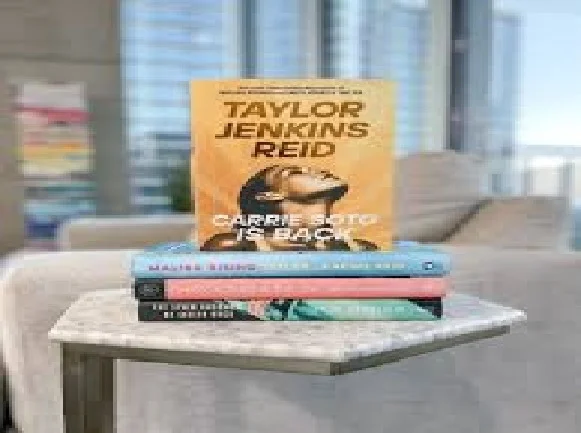If you’ve been following bookish social media, you’ve likely heard about Taylor Jenkins Reid, a writer known for her captivating character-driven stories about musicians, actresses, and athletes. With Carrie Soto Is Back, Reid dives into the world of professional tennis, crafting a gripping tale that’s both a redemption story and a deep character study. This article takes a closer look at Carrie Soto Is Back and why it’s a standout in Reid’s collection.
Genre: Contemporary Fiction / Historical Fiction
Carrie Soto Is Back is a blend of contemporary and historical fiction. It centers on Carrie Soto, a retired tennis player who returns to the game to regain her title, and is mostly set in the 1990s. The novel combines personal struggles, professional ambition, and emotional depth to create an unforgettable narrative.
Content Warnings:
Before diving into the story, it’s important to note the content warnings, as Carrie Soto Is Back tackles themes that may be sensitive for some readers. These include:
- Ageism
- Alcohol abuse
- Cancer (past, off-page)
- Cheating
- Death of a loved one
- Misogyny
- Terminal illness
Who Should Read Carrie Soto Is Back?
If you’re in the mood for a powerful redemption story featuring an unlikeable yet ultimately inspiring protagonist, Carrie Soto Is Back is perfect for you. It’s a story about battling for your position in the world despite seemingly insurmountable odds. Fans of stories about ambitious, flawed characters—particularly those who loved The Seven Husbands of Evelyn Hugo—will find a lot to enjoy here.
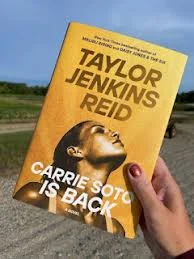
Taylor Jenkins Reid’s Mastery of Character-Driven Stories
Taylor Jenkins Reid has built a reputation for her complex characters, and Carrie Soto Is Back is no exception. Known for writing sweeping narratives about celebrities—whether they’re actresses like Evelyn Hugo or musicians like Daisy Jones—Reid has a knack for humanizing even the most unlikable figures. Carrie Soto, the novel’s protagonist, fits this mold perfectly.
Carrie first made her appearance in Malibu Rising, another Reid novel, where she was introduced as the woman who had an affair with the main character’s husband. This portrayal didn’t paint her in the best light. But in Carrie Soto Is Back, Reid flips the script and gives Carrie a chance to tell her side of the story. And what a story it is.
The Redemption Arc of Carrie Soto
At the center of the novel is Carrie Soto, a former tennis champion who held the record for most Grand Slam titles until Nicki Chan took that title from her in 1994. At the age of 37, Carrie decides to come out of retirement to reclaim her title. But Carrie is far from a likeable character. She’s sharp-tongued, cold, and driven almost to a fault.
However, it’s this very complexity that makes Carrie such a fascinating character. Her perfectionism and relentless drive to be the best, even at the cost of personal relationships, might make her difficult to root for, but they also make her deeply relatable for anyone who’s ever struggled with the fear of failure.
Carrie Soto: More Than a “Mean Girl”
At first glance, Carrie seems like the stereotypical “mean girl”—a woman who cuts others down and doesn’t care about anyone but herself. But as the novel progresses, it becomes clear that Carrie’s harsh exterior is a defense mechanism. She’s had to be tough to survive in a world that isn’t kind to women, especially women in sports who don’t fit the mold of youth and beauty.
The loss of her mother at a young age and the relentless scrutiny from the media has made Carrie guarded and unwilling to let anyone in, with one notable exception—her father.
The Father-Daughter Bond
One of the most touching aspects of Carrie Soto Is Back is the relationship between Carrie and her father, Javier Soto. A former tennis player himself, Javier now serves as Carrie’s coach. Their bond is both complicated and heartwarming. Javier is the one person who understands Carrie’s struggles, and his presence in her life helps to soften her tough exterior.
Their relationship blurs the lines between father and coach, creating moments of tension and tenderness. It’s through this bond that we see Carrie’s vulnerability, making her feel more human and less like the icy, driven athlete she appears to be.
Bowe Huntley: Carrie’s Love Interest
Bowe Huntley, a fellow tennis player and Carrie’s love interest, also plays a key role in the story. Their relationship is complex, built on a history of shared experiences and mutual respect. However, both Carrie and Bowe have their emotional baggage, and their connection is constantly tested by their personal issues.
Unlike many romances in contemporary fiction, the relationship between Carrie and Bowe doesn’t happen overnight. It’s a slow burn, with both characters learning to trust each other over time. Their love story feels refreshing and realistic, especially compared to the “instalove” trope seen in many novels today.
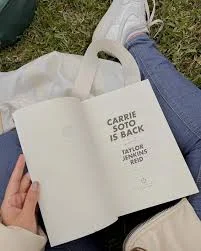
Tennis as a Metaphor for Life
While Carrie Soto Is Back revolves around the world of tennis, the sport is simply a vehicle for exploring deeper themes. Reid writes about tennis with precision, making the matches and training sessions feel vivid and intense. Even if you’re not a tennis fan, you’ll find yourself immersed in Carrie’s journey.
More importantly, the novel uses tennis to explore themes like perseverance, identity, and what it means to fight for something you love. Carrie’s comeback is not just about reclaiming her title—it’s about proving to herself that she’s still capable, still worthy.
The Evolution of Taylor Jenkins Reid’s Writing
Readers familiar with Taylor Jenkins Reid’s previous work might notice a shift in tone with Carrie Soto Is Back. While Daisy Jones & The Six and Malibu Rising were more focused on celebrity drama, Carrie Soto Is Back brings back some of the depth and intersectional commentary that made The Seven Husbands of Evelyn Hugo so memorable.
Reid explores issues of aging, misogyny, and identity, all through the lens of a woman who refuses to give up—even when the world tells her she should.
The Quintessential TJR Novel
As with her previous books, Taylor Jenkins Reid delivers a feminist deep dive into a male-dominated world, exploring the experiences of a woman who refuses to back down. Carrie Soto Is Back brings us nuanced characters, authentic relationships, and glamorous settings. Carrie Soto is an older woman of color, fighting to reclaim her place in the world of professional tennis—a sport where youth is prized.
This novel also brings back familiar faces from Reid’s earlier works, creating a “Taylor Jenkins Reid Cinematic Universe” (TJRCU) that avid fans will appreciate. While the world of Carrie Soto Is Back feels larger than life, at its core, it’s a story about one woman’s journey to prove herself—again.
The Plot: A Story of Redemption
Carrie Soto is not a character everyone loves. She’s driven, unapologetically fierce, and willing to sacrifice anything to stay at the top of her game. She will have broken records and won 20 Grand Slam titles by the time she quits from tennis. Her determination and laser focus have earned her the nickname “Battle-Axe,” a label that reflects both her attitude on the court and the world’s perception of her.
Six years after retiring, Carrie finds herself at the 1994 US Open, watching as Nicki Chan, a rising star, breaks her record. This moment lights a fire within Carrie, and at 37 years old, she makes the bold decision to come out of retirement for one last season. With her father and former coach, Javier Soto, guiding her, she sets out to reclaim her title.
Her return to the court isn’t smooth. The media has never been kind to her, her body doesn’t respond like it used to, and she’s forced to work with Bowe Huntley, a man she once had feelings for. Despite these challenges, Carrie is determined to show the world that she’s still the best.
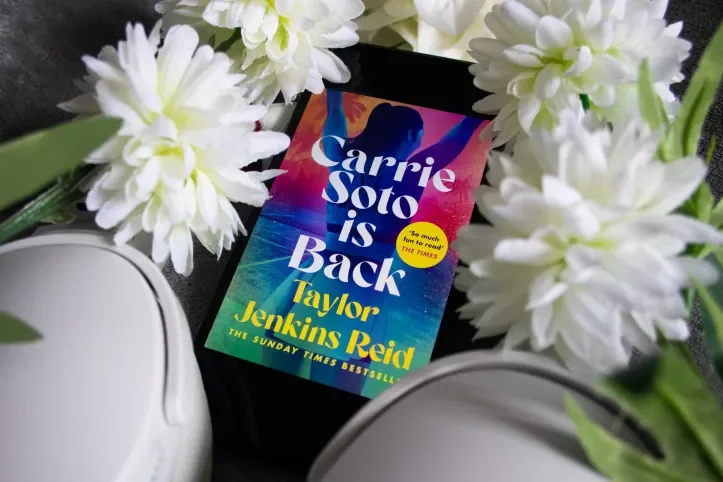
Carrie Soto’s Unlikable Yet Compelling Character
Carrie Soto is not your typical heroine. She’s difficult, often abrasive, and doesn’t care if people like her or not. But Reid’s writing has a way of making readers root for her. Carrie’s fierce desire to win and her unrelenting pursuit of perfection are relatable for anyone who’s ever struggled with the fear of failure. Carrie embodies the frustrations and struggles of many women who face constant judgment from the world, especially when they don’t fit into the mold of what society expects.
While many characters in literature fall into the “mean girl” trope, Carrie’s behavior is more nuanced. Her sharp words and defensive nature stem from a lifetime of fighting to prove herself. Growing up under the shadow of her father’s success, she felt constant pressure to achieve greatness. It’s only through the course of the novel that we see the vulnerable side of Carrie—a woman who is scared of losing not only her titles but her sense of identity.
Relationships: Javier Soto and Bowe Huntley
One of the most touching aspects of Carrie Soto Is Back is Carrie’s relationship with her father, Javier Soto. As her coach and mentor, Javier has been with Carrie since the beginning of her career. The father-daughter bond is complex—blurring the lines between personal and professional, but deeply emotional. Javier’s wisdom, experience, and unconditional love serve as a foundation for Carrie’s character development.
Bowe Huntley, a former tennis star with a history of on-court tantrums, adds an additional layer to Carrie’s story. Their romantic tension is palpable, but what makes their relationship unique is how it unfolds slowly over time. Instead of a fast-paced romance, their relationship grows naturally, making their bond feel genuine and relatable.
The interactions between Bowe, Carrie, and Javier bring depth to the story. While Carrie’s main goal is to reclaim her title, these relationships are at the heart of her personal growth.
The Sports Angle: More Than Just Tennis
If you’re worried about Carrie Soto Is Back being too tennis-focused, rest assured. Even if tennis isn’t your sport, Reid’s sharp, detailed writing draws you into the game. The intensity of the matches and training sessions is captivating, but tennis serves as more than just a backdrop. It’s the vehicle through which themes of perseverance, identity, and resilience are explored. Whether you’re a fan of the sport or not, you’ll find yourself glued to the page, eagerly awaiting the outcome of each match.
Carrie Soto’s Character Evolution
At the beginning of the novel, Carrie believes that all she needs to do is get back into shape and play well to reclaim her title. But as the story progresses, she realizes that winning is about more than just skill. Carrie has to confront her past mistakes, reevaluate her relationships, and ultimately decide what’s truly important in life. Her growth is a powerful reminder that success is not just about titles and trophies but also about finding balance and happiness.
A Story of Representation and Intersectionality
One of the novel’s strengths is its exploration of identity and representation. Carrie, as a Latina woman, faces sexism and ageism in her sport. Her rival, Nicki Chan, a queer Asian woman, also brings a different perspective to the story. While Taylor Jenkins Reid doesn’t delve as deeply into these identities as some readers might hope, their presence adds complexity and nuance to the novel. The struggles these women face are not just about winning on the court but also about fighting for respect and recognition in a world that often marginalizes them.
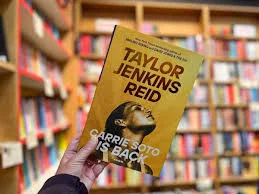
Conclusion: Why You Should Read Carrie Soto Is Back
Carrie Soto Is Back is a novel about resilience, identity, and the pursuit of greatness. Taylor Jenkins Reid brings us a character who is unapologetically fierce, flawed, and determined to win at all costs. While the story revolves around tennis, its themes of redemption and personal growth make it a powerful read for anyone who’s ever faced failure or the fear of losing their identity.
This novel may not delve as deeply into its Latinx representation as some might hope, but Carrie Soto’s journey is nonetheless a compelling one. For fans of Reid’s previous works, this is a must-read, and for new readers, it’s a gripping introduction to her talent for storytelling.
FAQs
- Is Carrie Soto Is Back suitable for non-sports fans?
Yes! While tennis is central to the plot, the story focuses on themes of resilience, identity, and personal growth, making it accessible to all readers. - Does Carrie Soto Is Back explore Latinx representation?
The novel touches on Carrie’s identity as a Latina woman, though some readers may feel it lacks depth in this area. - Is this book part of the Taylor Jenkins Reid universe?
Yes, there are subtle nods to characters from Reid’s previous novels. - What makes Carrie Soto different from other TJR characters?
Carrie is fiercely unlikable yet compelling. Her intense desire to win and her fear of failure make her character stand out.
For getting more information Thezvideo.

